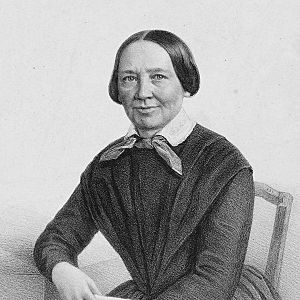Emilie Zumsteeg facts for kids
Emilie Zumsteeg (born December 9, 1796 – died August 1, 1857) was a talented German musician. She was a conductor for choirs, a singer, a composer, and a pianist.
Emilie's Early Life and Music
Emilie Zumsteeg was born in Stuttgart, Germany. She lived there her whole life. She was one of seven children. Her father, Johann Rudolf Zumsteeg, was also a composer. Sadly, her father died when Emilie was only six years old.
After her father passed away, Emilie's mother ran a music store. This helped Emilie become even more interested in music. As a child, Emilie took piano lessons. She also studied music theory, which is about how music is put together.
Emilie was very good at sight-reading. This means she could read and play music she had never seen before. She also had a beautiful alto voice, which is a low female singing voice. Soon, she began singing and playing the piano in concerts in Stuttgart.
Emilie's Musical Career
As an adult, Emilie became friends with many talented musicians and famous poets. Her friendships with poets helped her with her own music. She loved writing "lieder," which are German songs for a singer and piano.
In 1830, Emilie started the very first women's choir in Württemberg. This was a big step for women in music at the time. She also taught voice and piano lessons. She was an important member of a group called the Verein für Klassische Kirchenmusik. This group focused on classical church music.
Emilie Zumsteeg died in Stuttgart when she was 60 years old.
Emilie's Compositions
Emilie Zumsteeg wrote about sixty songs. She also composed an overture (a piece of music played at the start of an opera or play), piano pieces, and three polonaises (a type of Polish dance).
Her early piano works, like Trois Polonaises from 1821, were praised in music newspapers. She also wrote sacred choral music, which is music for choirs to sing in church.
Emilie was probably best known for her songs. They became very popular in her home country and beyond. One of her songs was even used later by a Russian leader and became known as the "Prisoners' Song." In 1842, her collection of songs called Lieder, Op. 6 received good reviews in national newspapers.
People thought Emilie's music was very new and creative for her time. Her songs often needed a wider vocal range than usual, showing how adventurous her compositions were. Some of her earlier songs were simple, but others showed an "Italianate flair," meaning they had a lively, flowing style like Italian music.
Her unique style can be seen in songs like Ich denke Dein and Des Freundes Wunsch. Two of her lieder are even included in a special music series called Frauen komponieren (Women Compose).
Music experts have studied Emilie's work. They praise her creative freedom. Some even think her music might have influenced other famous composers like Franz Schubert. One of her songs, "Sehnsucht der Liebe," is considered a lovely piece. It has a slow first part (called adagio) and a fast second part (called allegro vivace). This shows how she could combine peaceful night feelings with lively human emotions in her music.
More research is needed to fully understand all of Emilie Zumsteeg's amazing compositions.


